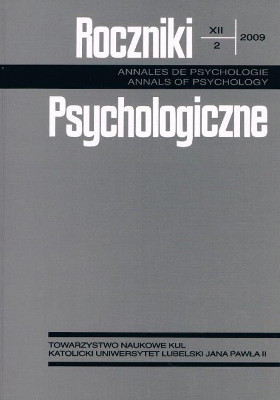Types day-dreamers among middle-aged women
Abstract
The article describes results of research, whose aim was to distinguish different types of women day-dreamers, taking into consideration the changes in day-dreaming occurring over the development from adolescence to middle age. For the purpose of defining precisely the meaning of the “day-dream” concept, the definitions of this term proposed by various authors were analyzed. To situate day-dreaming within the life span, the conception of Levinson was used. To analyze the results of research, an eclectic categorization as used. The mid-life crisis and its connections with day-dreaming were also described. One-hundred-twelve women, aged 35-50 with the secondary education and higher, participated in research. The following research methods were used: the structured interview concerning dreams and The Midlife Crisis Questionnaire (version for women by Ole and Baranowska, 2003). Cluster analysis was used as a statistical method. Five types of day-dreamers were distinguished, taking into consideration the following criteria: the contents of youthful dreams, origin, a degree of concreteness and the feeling of fulfillment of youthful dreams, the boldness of current dreams and the faith into their fulfillment. Types of dreamers: 1) stable traditional, 2) mutable traditional – autonomic, 3) stable autonomic, 4) mutable autonomic, 5) moderate stable traditional – autonomic. The associations of the particular types of dreamers with dimensions of mid-life crisis were also analyzed and the typology was found to be related to the scores on the Negative Changes Awareness scale.
References
Archer, S. L. (1985). Career and (or) family: The identity process for adolescent girls. Youth and Society, 16, 3, 67-79.
Banister, E. M. (1999). Women’s midlife experience of their changing bodies. Qualitative Health Research, 9, 520-537.
Drebing, C. E., Gooden, W. E. (1991). The impact of the dream on mental health functioning in the male midlife transition. International Journal of Aging and Human Development, 32, 227-287.
Drebing, C. E., Gooden, W. E., Drebing, S. M., van de Kemp, H., Malony, H. N. (1995). The dream in midlife women. Its impact on mental health. International Journal of Aging and Human Development, 40, 73-87.
Erikson, E. H. (1980). Identity and the life cycle. New York: W.W. Norton and Co.
Fhaner, S. (1996). Słownik psychoanalizy. Gdańsk: Gdańskie Wydawnictwo Psychologiczne.
Freud, S. (1997). Poza zasadą przyjemności. Warszawa: Wydawnictwa Naukowe PWN.
Gould, R. (1972). The phases of adult life. A study in developmental psychology. American Journal ofPsychiatry, 129, 521-531.
Harker, M., Solomon, M. (1996). Change in goals and values of men and women from early to mature adulthood. Journal of Adult .Development, 3, 133-143.
Jackelen-Sterner, M. (2001). Following the dream. A study of selected graduate students in counseling degree programs. A research paper. The Graduate School University of Wisconsin-Stout; http://www.uwstout.edu/lib/thesis/2001/2001jackelensternerm.pdf
Jung, C. G. (1972). Collected works. London: Routledge & Kagan Paul.
Kałużna, A. (2005). Obraz marzeń kobiet w wieku średnim (mps pracy doktorskiej, Uniwersytet Jagielloński).
Levinson, D. J., Darorow, C., Klein, E., Levinson, M., McKee, B. (1978). The Seasons of a man’s life. New York: Knopf.
Levinson, D. J., Levinson, J. (1996). The seasons of woman’s life. New York: Knopf.
Livson, F. B. (1981). Path to psychological health in the middle years. Sex differences. W: D. H. Eichorn, J. A. Clausen, N. Haan, M. P. Honzik, P. B. Mussen (red.), Present and past in middle life (s. 195-221). New York: Academic Press.
Łukaszewski, W. (1984). Szanse rozwoju osobowości. Warszawa: Książka i Wiedza.
McAdams, D. P. (1985). Power, intimacy and the life story. Illinois: The Dorsey Press, Homewood.
McAdams, D. P., de St. Aubin, E., Logan, R. L. (1993). Generativity among young, midlife, and older adults. Psychology and Aging, 8, 221-230.
Miluska, J. (1995). Przekształcanie ról płciowych a szanse kobiet. W: J. Miluska, E. Pakszys (red.), Humanistyka i płeć. Studia kobiece z psychologii, filozofii i historii (s. 19-38). Poznań: Wydawnictwo Naukowe UAM.
Neuegarten, B. (1969). Continuities and distinuities of psychological issues into adult life. Human Development, 12, 121-130.
Obuchowski, K. (1993). Człowiek intencjonalny. Warszawa: PWN.
Olejnik, M. (2002). Średnia dorosłość. Wiek średni. W: B. Harwas-Napierała, J. Trempała (red.), Psychologia rozwoju człowieka (t. 2, s. 234-262). Warszawa: PWN.
Oleś, P. (1995). Kryzys „połowy życia” u mężczyzn - psychologiczne badania empiryczne. Lublin: RW KUL.
Oleś, P. (2000). Psychologia przełomu połowy życia. Lublin: Towarzystwo Naukowe KUL.
Oleś, P., Baranowska, M. (2003). Przełom połowy życia u kobiet. W: J. Meder (red.), Problemy zdrowia psychicznego kobiet (s. 151-160). Kraków: Redakcja Polskiego Towarzystwa Psychiatrycznego.
Ostrowska, A. (2003). Problemy zdrowia kobiet z perspektywy socjologii medycyny. W: J. Meder (red.), Problemy zdrowia psychicznego kobiet (s. 11-24). Kraków: Redakcja Polskiego Towarzystwa Psychiatrycznego.
Puchalska-Wasyl, M. (1999). Rodzina i praca w systemie osobistych znaczeń kobiet pracujących naukowo. Roczniki Psychologiczne, 2, 167-184.
Quaglia, R. (1989). Student aspirations. A critical dimension in effective schools. Research in Rural Education, 6, 2, 7-9.
Quaglia, R., Perry, C. (1995). A study of underlying variables affecting aspirations of rural adolescents. Adolescence, 30, 233-244.
Sęk, H. (1990). Kryzys wieku średniego a funkcjonowanie w społecznych rolach rodzinnych. W: M. Tyszkowa (red.), Rodzina a rozwój jednostki (s. 89-112). Poznań: CPBP.
Shek, D. T. (1996). Midlife crisis in Chinese men and women. Journal of Psychology, 130, 109-120.
Singer, J. L. (1980). Marzenia dzienne. Warszawa: PWN.
Singer, J. L. (1976). Daydreaming and fantasy. London: George Allen & Unwin LTD. Vaillant, G. E. (1977). Adaptation to life. Boston: Little, Brown.
Copyright (c) 2009 Roczniki Psychologiczne

This work is licensed under a Creative Commons Attribution-NonCommercial-NoDerivatives 4.0 International License.


